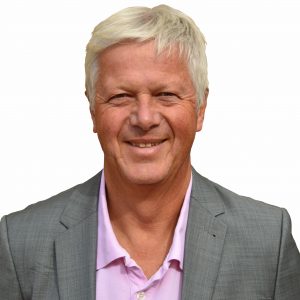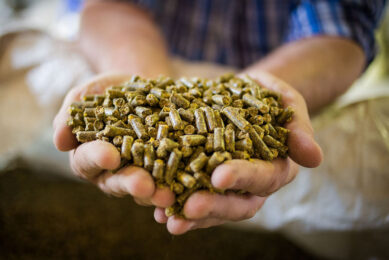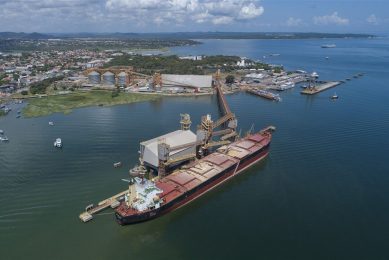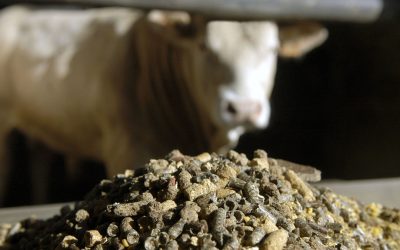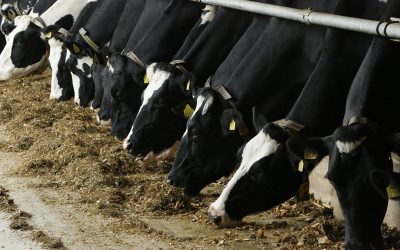Kombikorna: Cereals-Mixed Feed- Veterinary exhibition, Moscow
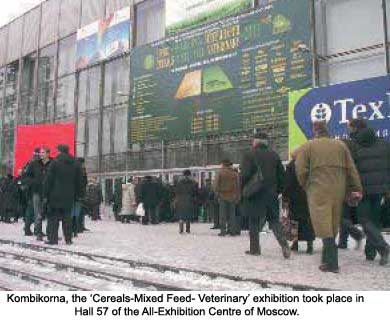
The 16th edition of the Cereals-Mixed Feed-Veterinary exhibition took place in the All-Exhibition Centre of Moscow from the 1- 4 February with the participation of more than 300 exhibitors from 23 countries and 43 Russian regions.
By Philippe Caldier
Organised since 1996 by Expokhleb, the Cereals-Mixed Feed (Kombikorna) -Veterinary exhibition is still the leading exhibition of eastern and central Europe which only focuses on animal feed. Equipment and feed technology, transport, storage and drying of grain, raw materials and veterinary industry are the leading topics of the exhibition. The number of foreign exhibitors steadily increases every year. Among the 23 exhibiting countries, Germany and the Netherlands dominate with respectively 16 and 9 exhibitors. The other significant present countries are Austria, Denmark (whose exhibitors are feed plant specialists such as Andritz or Lachenmeier), the USA with Abel Manufacturing, Brock International, Cargill, Elanco, Global Industries, Insta Pro, Scafco Grain systems, Val-Co) and France, being represented by six companies: Adisseo, Bonilait Protéines, Ceva Santé animale, Morillon, Nutristar international and Olmix. Exhibitors also came to Moscow from other eastern European countries such as Belarus, Czech Republic, Baltic countries, Ukraine and Poland.
New feed plant in Koursk
The Moscow exhibition is a good place to meet leading European providers of feed plants who are all very active in the growing Russian market. Among them was BDW Feedmillsystems, a German company working in Russia for some years, particularly in the Belgorod region where it launched a new feed plant in September 2009. This plant, built in Livenka for the Agro-Belogore group, has an annual capacity of 150,000 t feed (mainly pig feed) plus a storage capacity of 30,000 t grain.
“We are actually starting a larger project in Koursk (located 550 km south-west from Moscow near the border with Ukraine),” explained Heirich Wolking, director at BDW. His client is a leading pig integrator whose new feed plant for pigs and poultry will have a capacity of 15 tph (Kahl equipment). This project, also with 80,000 t of grain storage (Riele silos), should be ready by the end of 2011. “2011 is expected to be better than 2009 and 2010,” estimated Wolking whose Russian clients are mostly integrators investing again. “We have started several new projects in Russia since the end of 2010 after three bad years,” added Michail Dolud, CIS area manager of Kahl. The German company from Hamburg has been active in Russia since 1989 where it has around 15 references. “Our customers’ size is between 10 and 20 tph,” Dolud said. Among its new clients, Kahl is building a new pelleting line for Omskyi bacon, the first Russian pig integrator located in Omsk (Siberia). Kahl is also active in Belarus and in Ukraine. “Belarus has been very active for some years in the feed business while we focus on further investments in the Ukraine in straw pelleting lines for fuel pellets,” Dolud added.
More competition
“The crisis is almost over but the business is still difficult,” said Sergei Mourylev in Moscow. He is CIS export manager for Bonilait Protéines, French manufacturer of fat-filled dairy ingredients in powder form for the food and animal feed industry. Thanks to an exclusive Russian distributor (Prodinvest) the company can cover the whole country. “We have kept our business in 2010 in spite of a growing competition from other western European countries,” Mourylev added. He thinks innovation will be key in holding on to business in a market where price is still the leading value.
Premix with bentonite
Leading feed producer from Belgorod region, Shebekinske Korma received from the Moscow exhibition the grand prize for innovation with its premix Vital Ultra enriched with bentonite (mineral clay). The company started its activity in 1976 and has a wide range of products: compound feed (the annual production capacity of the feed plant, rebuilt in 2007, is 60,000 t), premixes (the new production line built in 2008 with a capacity of 60,000 t required more than €3 million investments), and concentrates of minerals and vitamins (new production line rebuilt in 2009 with annual production capacity of 12,000 t). Since 2008, the company has offered to its clients a premix enriched with selenium and iodine and is further improving a premix enriched in bentonite called Vital Ultra.
Nanotechnology specialists from the University of Belgorod have been doing successful trials on it since 2009 with Shebekinske Korma. Trials conclude better growing performances of animals fed with premix enriched in bentonite, with a return-of-investment of 4-5:1 rubles (1 € ~ 40 rubles). The cristalline structure of bentonite enhances the absorption of heavy metals and other toxic substances.
Shebekinske Korma is working on three new investment projects:
• New prestarter line for young animals (chicks, piglets and calves) with a capacity of 48,000 tpy. The forecasted investments will reach €7 million and this new line should start in the third quarter of 2011;
• Building of a L-Lysine plant, the first in Russia. The country imports all its lysine needs. The investment will be around €60 million and production is estimated to start in the second quarter of 2012. The plant will use European and American technologies and will produce lysine 27% to 30% cheaper than the imported products;
“Our clients suffered a lot last summer and we have to help them to drop their feed costs,” argued Aleksandra Dolgopolova at Shebekinske Korma’s stand. She is a public relations manager. She stated that feed wheat prices have increased by 250% last summer compared to the previous year, while barley prices jumped by 400%! The compound feed prices consequently increased by 10% to 50% depending on the species (cattle feed prices increased more severely). “We also started last October to organise seminars with our clients with the help of Russian livestock Institutes. The goal of these seminars is to help farmers to overcome possible next hot periods,” she added.
Feed and premix investments
Other feed companies exhibited in Moscow renovation projects or new facilities being built. Magnitorskyi Poultry Komplex (MPK) is about to launch a premix plant in Magnitogorsk (Ural region). “We should start our premix plant within three months,” explained Olga Dilbina, commercial agent of the feed plant. MPK is a leading producer of poultry and eggs in the Ural region, selling its products under the ‘Sitno’ brand.
“Our Efremov plant has a capacity of 240,000 t of compound feed and we expect to increase it to 350, 000 t,” said Vitaly Akimov, sales manager for Cargill Animal Nutrition Russia. Cargill started its business in Russia in 1991, and began producing feed in 2009 by investing in Efremov located in the Toula region, 300 km south of Moscow. From then on Cargill continued to develop its animal nutrition business in Russia and began the construction of a second plant at the Efremov site to produce pelleted pre-starters, vitamin-mineral premixes and protein-vitamin-mineral concentrates for swine and poultry. The capacity of the plant is 50,000 tonnes of feed per year. A further step was made last year when it started the construction of its first poultry processing facility in Russia. The majority of products will be supplied to McDonald’s in Russia. “The Efremov feed plant received the HACCP certificate in 2010,” said Akimov at a press conference organised during the exhibition. “Our goal is to optimise feed costs for our dairy clients to improve the quality of the ration and dairy efficiency,” he added. In order to achieve this goal, Cargill uses its “Dairy-Max” programme for optimisation of the ration which includes physical properties evaluation indexes of the used ingredients in order to forecast yield and milk quality.
Valeryi Afanasiev: “Russia needs 51 million tonnes of feed in 2012”An interesting day of conferences was organised during the exhibition, giving a good overview of the Russian feed sector. Valeryi Afanasiev, president of the Russian Feed Industry Association, started this forum with some key figures about feed in Russia. According to Ross-stat official statistics, Russia produced 14.6 million tonnes of feed in 2009 (+6.8% compared to 2008). In 2010, in spite of the hot summer, feed production even jumped by 9.1% (from January to September). But these statistics do not cover feed produced by integrated pig, dairy and poultry complexes whose feed production is estimated at 24.5 million tonnes in 2009 (vs 22.4 million tonnes in 2008), neither do they include feed use of private farmers estimated at around 19 million tonnes/year. “Private farmers need a credit system to cover their feed needs,” said Afanasiev who estimates that the total feed needs for all categories of farms will exceed 51 million tonnes by 2012 (see Table 1). “Our feed industry depends too much on imports,” he said which includes imports of raw materials, of vitamins, premix and also of equipments. “We should produce more protein as oilseeds such as rape seed in order to have more balanced feed,” he said. “We will build five to six new premix plants in the coming years,” Afanasiev said and then described the profile of the 259 registered Russian feed plants (Table 2). The statistics also show 193 ‘units and machines’ (home mixers) in two categories: from 1,000 to 5,000 t/y (104 units), the rest being lower than 1,000 t/y. Afanasiev stated foreign equipment accounts for around 23% of the existing Russian feed mills, and for 70% of the new feed plants. “We should support our own feed equipment industry more, which is on the decline.” For the first time at the forum Afanasiev welcomed Alexander Döring, FEFAC General Secretary and Marek Kumprecht, member of FEFAC Presidium. Since July 2010, Russia is an ‘observer member’ of FEFAC together with Turkey, Serbia and Croatia. “As Russia will soon join WTO, we need to exchange more with FEFAC and western European countries, particularly about feed safety,” Afanasiev concluded. |


